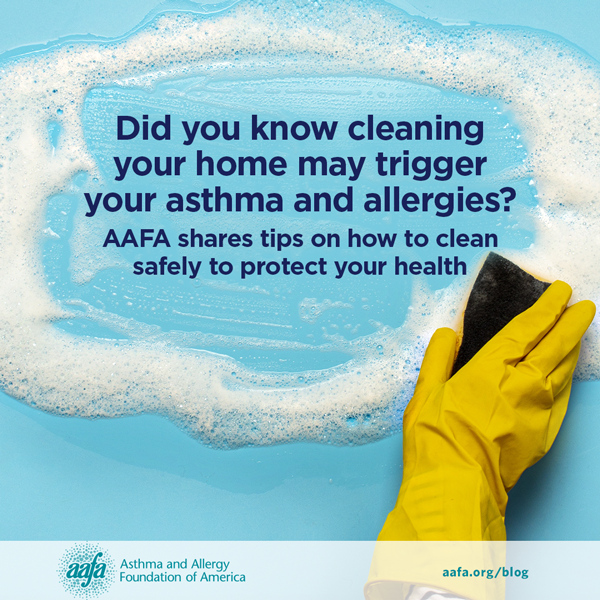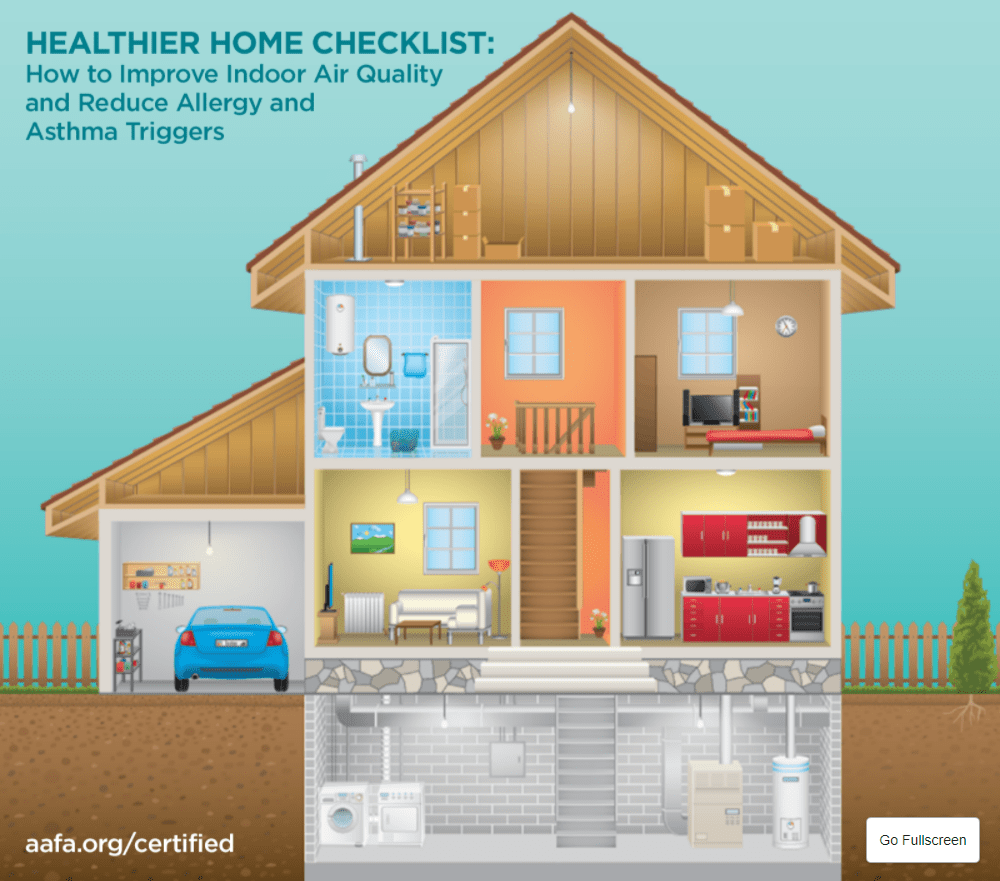When you have asthma, how you clean your home is an important part of asthma control. You want to reduce or remove allergens and triggers like mold, pests, dust mites, and animal dander. A multi-part cleaning plan will be most effective.
Clean your home regularly to reduce the spread of the coronavirus (SARS-CoV-2) that causes COVID-19 or other respiratory illnesses like influenza (flu). To prevent asthma symptoms, clean and disinfect your home in a way that kills the viruses and is asthma friendly.
Cleaning Can Worsen Indoor Air Quality
When you’re cleaning, you may actually spread asthma triggers or worsen your indoor air quality. Some tools like feather dusters only move dust around, which can spread dust mites and small particles through the air. Some vacuum cleaners can leak air, spitting the particles from your carpet right back into the air.
And then there’s cleaning products. The very solutions that clean can actually cause asthma symptoms. Many cleaning products contain strong scents, chemicals, and volatile organic compounds (VOCs) that can trigger asthma. One study found that regular use of cleaning products was as harmful as smoking several cigarettes a day.1 Some products may remove some allergens and asthma triggers but can still irritate your lungs.

Cleaning Versus Disinfecting Versus Sanitizing
Did you know cleaning products don’t always disinfect, and disinfectants don’t always clean? And what’s the difference between cleaning, disinfecting, and sanitizing?
- Cleaning removes dirt and germs. This can be done simply with soap and water.
- Disinfecting uses chemicals to kill germs. It does not clean or remove the germs.
- Sanitizing reduces the number of germs to a safe level. A surface is considered sanitized when either cleaning and/or disinfecting reduces the germs to safe level according to public health guidelines.
To properly sanitize a surface, clean first to remove germs, dirt, and residue. Then disinfect to kill remaining germs.
Asthma-Friendly Cleaning Tips
If you have asthma or live with someone with asthma, create a plan on how to clean and sanitize your home. Try these tips to reduce exposure to asthma triggers:
- Use liquid or gel cleaners instead of commercial spray cleaners, and choose unscented products when possible. Wear a face mask and gloves (latex free if you are allergic to latex).
- Open windows and run fans during cleaning.
- Change your clothes and take a shower after cleaning.
- Use a damp cloth to remove dust or use CERTIFIED asthma & allergy friendly® dusting cloths that trap dust particles.
- Vacuum at least weekly with a CERTIFIED vacuum with HEPA filtration, or use washable throw rugs and wash them in hot water (130 F or hotter) weekly.
- Some vacuums cause particles from the floor to get into the air. This can trigger asthma symptoms. If possible, have someone without asthma do the vacuuming while people with asthma are not in the room.
- Some vacuums cause particles from the floor to get into the air. This can trigger asthma symptoms. If possible, have someone without asthma do the vacuuming while people with asthma are not in the room.
- Wash bedding in hot water weekly.
- Reduce clutter that tends to collect dust.
- Run an exhaust fan in your bathroom for 15 to 20 minutes after showering to reduce mold growth.
- Remove mold at first sight with soap, warm water, and a brush. If the mold doesn’t remove easily with soap and water, a person without asthma can use a bleach solution if there is good air ventilation.
- Have someone without asthma clean for you, if possible. Wearing a mask while you clean may help reduce your exposure to asthma triggers.
Cleaning to Prevent the Spread of the Coronavirus
The Centers for Disease Control and Prevention (CDC) recommends that you clean regularly to reduce the spread of the new coronavirus. But not every cleaning product will kill the virus.
These cleaning solutions will kill the virus that causes COVID-19 when used properly:
- Undiluted rubbing alcohol (at least 70% ethyl or isopropyl) – Leave on the surface for at least 30 seconds.2
- Hydrogen peroxide 3% concentration – Leave on the surface for 1 minute.3
- Bleach (5 tablespoons or 1/3 cup per gallon of water OR 4 teaspoons per quart of water) with a sodium hypochlorite concentration of 5 to 6% – Leave on the surface for 1 minute.4
Bleach is a common asthma trigger. People with asthma should avoid using bleach or areas where bleach is being used when possible. If you must use bleach:
- Mix it in the right proportion
- Wear a mask and gloves
- Use it in a well-ventilated room
- Don’t mix bleach and ammonia
- Have someone else clean for you, if possible
Vinegar and essential oils (like tea tree oil) are not EPA-registered disinfectants and will not kill the new coronavirus.
For a list of more cleaners, see the full list of EPA-registered disinfectants for use against COVID-19.
Homemade Cleaners for General Cleaning
Simple soap and warm water can be effective in many cases for general cleaning. But you’ll want to use something else to disinfect (kill germs).
Homemade cleaning recipes using baking soda, vinegar, borax, hydrogen peroxide, or dish soap may be less likely to cause asthma symptoms. Some people who are sensitive to scents prefer to use steam cleaners to clean. (But be careful if steam triggers your asthma.) Some homemade cleaning recipes call for using essential oils, like tea tree oil. But essential oils can actually be an asthma trigger because of their strong scents, and they release VOCs.
The Environmental Protection Agency (EPA) reviews cleaning products to help you choose options that are better for your health and the environment. You can view the EPA’s Safer Choice products list to find options.
Want to talk about asthma-friendly cleaning options or share your own tips? Join our online community. You can talk with other people managing asthma and allergies in a positive, supportive environment.
References
1. Svanes, Ø, Bertelsen, R. J., Lygre, S. H., Carsin, A. E., Antó, J. M., Forsberg, B.,... Svanes, C. (2018). Cleaning at Home and at Work in Relation to Lung Function Decline and Airway Obstruction. American Journal of Respiratory and Critical Care Medicine, 197(9), 1157-1163. doi:10.1164/rccm.201706-1311oc
2. Cleaning and Disinfection for Households. (2020, May 27). Retrieved June 22, 2020, from https://www.cdc.gov/coronaviru...ng-disinfection.html3. Chemical Disinfectants. (2016, September 18). Retrieved June 22, 2020, from https://www.cdc.gov/infectionc...ethods/chemical.html4. Cleaning and Disinfection for Households. (2020, May 27). Retrieved June 22, 2020, from https://www.cdc.gov/coronaviru...ng-disinfection.html



Comments (3)